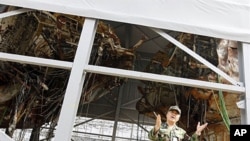North Korea has angrily rejected a multinational investigative team's findings that it was responsible for the deadly sinking of a South Korean naval ship. The investigators says it is beyond doubt a North Korean submarine fired a torpedo and split the ship in half.
North Korea's National Defense Commission issued a statement Thursday calling the international team's findings "sheer fabrication," and a "conspiratorial farce." It warns Pyongyang will meet any retaliation with "tough measures, including an all-out war." The North is also vowing to send a team to South Korea to inspect the evidence for itself.
Just a short while earlier, the international team made public its conclusion that North Korea was involved in the sinking of the Cheonan, a South Korean warship. It marked the first time South Korea has explicitly and publicly blamed North Korea for the sinking.
Yoon Duk-yong is the South Korean co-director of the team. He says it is clear the sunk by a torpedo made in North Korea. He says the evidence points overwhelmingly to the conclusion that the torpedo was fired by a North Korean submarine. He says there is no other plausible explanation.
Yoon says his team can also confirm a submarine team left a North Korean naval base two or three days before the attack, and returned home two or three days after the ship was sunk.
The team went into deep forensic detail. South Korean military intelligence analyst Hwang Won-dong pointed to what he says are recovered pieces of a torpedo with Korean language markings. He says he knows of no other nation besides North Korea that would mark their torpedoes using the Korean alphabet.
Lee Geun-duk, an explosives analyst, pointed to residue found both on the recovered torpedo parts and on the damaged hull of the Cheonan. He says the team determined the substance found on the torpedo propeller and on the Cheonan are identical.
The Cheonan investigative team brought in analysts from the United States, Australia, the United Kingdom and Sweden. U.S. Navy Rear Admiral Thomas Eccles, who directed the American investigative team, says none of the nations involved in the probe dispute its conclusions.
"The international team, in close cooperation with the Republic of Korea joint investigative group, worked both in a collaborative way - very closely together - and also employing our separate tools and methods... and in all of those, we found agreement both within the Republic of Korea and all of the international team," said Eccles.
Forty-six South Korean sailors were killed in the sinking of the Cheonan. A South Korean military reprisal is seen as almost impossible, because of the chance that action could escalate into a devastating war. South Korea says it will call for coordinated international action via the United Nations Security Council and the United Nations Commission that monitors an armistice between the two Korea's.
S. Korea Blames North for Attack on Warship








